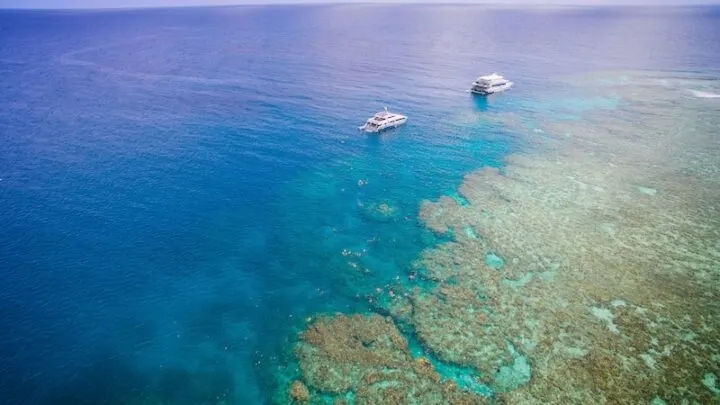The Great Barrier reef in Australia has long been most diver’s dream, but with the recent reports on the death of the corals within it, is it still worth the visit? We talk to Sandra Norman who specialises on trips to the GBR to find out more and see what the best options for liveaboards on the Great Barrier Reef are.
Where is the Great Barrier Reef?
The Great Barrier Reef is the world’s largest living structure on Earth. Located in the Coral Sea, off the northeast coast of Australia, it has both inner and outer reefs. The tropical city of Cairns being the port of call for all the liveaboard dive boats.
How do I get there?
Getting to Cairns, particularly if you have limited time, is best by air. The airport handles domestic and international flights. Cairns is at a latitude of 16.9o south of the equator. If you are touring Australia by road, then Cairns is in the far north of the state of Queensland. To give you a sense of distance, it is around 1,684 kilometres (1,046 miles) by road from the state capital, Brisbane, to Cairns.
How do I choose the right trip?
Choosing the right trip for your diving holiday may seem daunting but with some expert knowledge it can be made easy. There are several aspects to consider and doing this narrows down your choices for the most suitable trip.
The dive boats are known as “liveaboards”. If you have never been on a liveaboard before, it might be hard to know what to look for when reading through websites. Whether new to diving or experienced, you may have many questions running through your head about life at sea. We will be covering two types of liveaboards; trips available all-year-round and the Minke Whale trips, which are in June and July.
Year-Round Liveaboards
How many nights onboard?
You can choose from one, two or more nights, right up to a great onboard experience lasting for a week or more. Solo travellers are always buddied-up with a suitable dive companion. The larger liveaboard boats which are more like reef hotels, are up to 40m (120 feet) long and only carry a maximum of 42 passengers, staying on the outer reefs and moving between dive sites a couple of times per day.
Your transfers to and from theses liveaboards are via their fast day-boats that travel between Cairns and the outer reefs. As there are daily transfers, you book the number of nights onboard that you prefer.
There are also smaller liveaboards, 25m (80 feet) carrying up to 32 passengers, that directly depart Cairns, however they only spend two nights out on the reef before returning to Cairns to prepare for their next journey.
Number of dives per day and night
Each boat has set number of dives per day, some have four and others have five – including a night dive. You don’t have to participate in all the dives, so it’s fine to sit some out, sleep in or snorkel instead. The largest vessel also offers the extra options of ‘Fluoro Night Dives’ and ‘Sharks in the Dark’ to add to your total experience.
Enriched Air Nitrox courses/fills and other courses
Most boats offer the option to dive on Nitrox or complete your Nitrox course. All boats offer courses e.g. Open Water, Advanced Open Water and specialties. If there is a course you would like to do check availability before booking. At-sea courses are great value while on the liveaboard.
The style and size of liveaboard boats
Smaller vessels don’t necessarily mean fewer people are onboard, and they have smaller cabins and fewer areas to relax in. Cabins are designed for two, four or more passengers. There may be tight stairwells to negotiate to cabins below decks. But for those who like a cosy environment and a quick trip, a small boat might be a perfect option.The larger boats are more comfortable, with bigger cabins and more places to relax include a dining room, lounge/bar, sundecks and shaded areas. There are two passengers in each standard cabin, with private en suite facilities. Some of the liveaboards have normal-height beds, others have bunk beds. Some have real mattresses while others are made of soft foam. There are also family cabins with en suites, with triple or quad share berths. Check out the different kinds of liveaboards in the Great Barrier Reef here.
Pricing
Gear hire – this varies between operators and can either be free or have a surcharge. If you own your own dive gear you can take it along.
Tariffs – the all-year-round trips vary a little in price when making comparisons, even considering number of nights onboard, more facilities and conveniences are not necessarily reflected by higher priced tariffs. A bonus is the pricing stays the same throughout the whole year.
With the above considerations made you will have a clearer idea of what will best suit you for your dive trip on the iconic Great Barrier Reef. All the trip options are suitable for new or experienced divers whether you are a group or travelling solo.
Minke Whale Liveaboards – June and July
On a northern section of the Great Barrier Reef is the area known as the Ribbon Reefs. Dwarf Minke Whales migrate to these warm waters after travelling from the cold Antarctic. Minkes like to seek out interactions with humans. This is the only place in the world where this close interaction occurs and is a must for any diver’s bucket list.
Each whale trip has a researcher onboard from James Cook University’s Minke Whale Project, who conducts information sessions for all passengers. This is recognised as a fabulous educational opportunity to coincide with your Minke Whale experience.
The Liveaboard
There is one Minke Whale liveaboard that I feel is best suited for experience and particularly new divers. OceanQuest is the vessel which stays within the protected waters of the outer reef all the time. It is the largest of the liveaboards and passenger numbers are kept to a maximum of 36 on these trips.
All cabins have en suite facilities, with twin, double or family cabin options.There are two other boats doing the Minke season, although they venture out of the reef, therefore suitable for more experienced divers.
How many nights onboard
The Minke Whale trips are four nights and four days, departing on Friday mornings and returning to port on Tuesday mornings.
Number of dives per day and night
You can enjoy up to 16 dives on a whale trip, including one dive each night. if you prefer to sit out a dive, rest, or snorkel, you are welcome to do so. Once contact has been initiated, and maintained, by the whales, there is snorkelling time alongside the Minkes.
Nitrox fills and courses
Nitrox fills are available, and you can complete the short course while at sea. This is a great way to save time.
Pricing
Gear hire – AUD $160 (U.S. $125) for full gear hire or you can take your own gear, weights and tanks supplied.Tariffs – Minke Whale trips on OceanQuest are reasonably priced considering the distance travelled, days aboard, and the unique experience of swimming with these incredible creatures.
In summary
Just like with standard reef trips, the Minke Whale experience is equally suited to new or seasoned divers, solo travellers or groups of two or more.
Extra information
- Pack lightly. Check out our liveaboard packing list for more advice!
- No shoes or flip flops are worn onboard
- Take your camera, charger, and a combination lock for your bag
- Hat, sunglasses, jacket
- Reef-friendly sunblock
- Remember your certification cards
- The larger boats have a bar for purchase of after-diving drinks or snacks
- Boats are staffed and crewed by dive professionals, also Guides, Dive Masters and Instructors
- There are briefings before dives and you can dive as buddy pairs/groups or with a Guide (some boats may have a small surcharge for this)
- Non-divers and snorkellers are welcome to accompany divers on all trips
- For the experienced seeking even greater adventures, there are all-year-round and whale trips venturing further northeast and to Osprey Reef. Strict conditions can apply for passengers due to the remoteness and potential sea conditions.

About the Author
Sandra Norman is founder of Scuba Sojourns, specialising in trips on the Great Barrier Reef. Sandra is passionate about diving the Reef and organises trips for independent travellers and groups, whether for the boat component or package deals. You can find more information at www.scubasojourns.com.au or on Scuba Sojourns Facebook page

